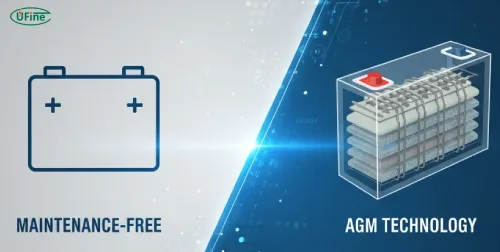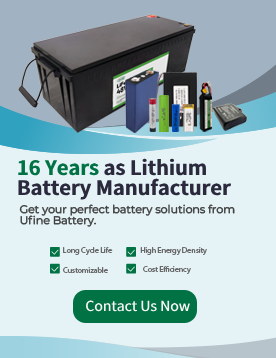
- Part 1. What is a maintenance-free battery?
- Part 2. How does a maintenance-free battery work?
- Part 3. Advantages of maintenance-free batteries
- Part 4. Disadvantages of maintenance-free batteries
- Part 5. Maintenance-free battery vs. conventional lead-acid battery
- Part 6. Maintenance-free battery vs. AGM battery
- Part 7. Maintenance-free battery types
- Part 8. How long does a maintenance-free battery last?
- Part 9. How to identify a maintenance-free battery
- Part 10. Who should buy a maintenance-free battery?
- Part 11. Maintenance tips (Even for ‘maintenance-free’ batteries)
- Part 12. Are maintenance-free batteries worth it?
Part 1. What is a maintenance-free battery?
If you own a car, motorcycle, or any vehicle that runs on a battery, you’ve probably heard about the maintenance-free battery. As the name suggests, it’s designed to operate without the regular maintenance tasks required by traditional lead-acid batteries — such as topping up electrolyte water or cleaning corrosion frequently.
Unlike conventional flooded batteries that require regular inspection and refilling, maintenance-free batteries are sealed and built for convenience. This means you can install one and virtually forget about it — ideal for drivers who want reliability without constant upkeep.
With more manufacturers shifting toward advanced battery technologies, the question arises: Should you buy a maintenance-free battery? Let’s explore what makes these batteries special and whether they’re the right fit for your vehicle.
Part 2. How does a maintenance-free battery work?
A maintenance-free battery works on the same basic principle as a lead-acid battery — converting chemical energy into electrical energy through an electrochemical reaction. However, its design is far more advanced.
Most maintenance-free batteries use Valve-Regulated Lead-Acid (VRLA) technology, which means the battery is sealed and equipped with pressure relief valves. Instead of losing water through evaporation, the gases produced during charging (hydrogen and oxygen) are recombined internally back into water.
This gas recombination process eliminates the need to add distilled water, making the battery “maintenance-free.” The sealed design also minimizes acid leakage, corrosion, and spillage — making it cleaner and safer to use.
Part 3. Advantages of maintenance-free batteries
The rising popularity of maintenance-free batteries isn’t surprising. They offer several benefits that appeal to both everyday drivers and professionals.
1 No Regular Maintenance
As the name implies, you don’t need to refill the electrolyte or check water levels. This saves time and effort, especially for users who aren’t familiar with battery care.
2 Longer Service Life
Maintenance-free batteries generally last longer than traditional lead-acid types due to their sealed design and corrosion-resistant plates. This design reduces water loss and minimizes internal degradation.
3 Safer and Cleaner Operation
Because the battery is sealed, there’s little to no risk of acid spills or gas emissions. This makes them ideal for modern cars, motorcycles, and even indoor applications like UPS systems.
4 Better Performance in Extreme Conditions
Maintenance-free batteries can deliver stable power even in harsh weather conditions. Their low self-discharge rate ensures reliable starting power even after long periods of inactivity.
5 Convenient Installation
They are typically factory-charged and ready to use upon installation. You don’t need to handle acid manually or perform complicated setup steps.
Part 4. Disadvantages of maintenance-free batteries
While they’re convenient and reliable, maintenance-free batteries do have a few drawbacks worth noting.
1 Higher Upfront Cost
They usually cost more than conventional flooded lead-acid batteries. However, their longer lifespan often offsets this higher initial expense.
2 Irreparable Design
Because they’re sealed, you can’t open them to refill electrolyte or perform repairs. Once the battery’s performance starts to degrade, replacement is usually the only option.
3 Sensitive to Overcharging
Overcharging can cause internal pressure buildup, leading to valve venting and potential performance loss. That’s why using a smart charger or voltage regulator is essential.
4 Limited Visibility of Battery Condition
Since the battery is sealed, you can’t visually inspect the electrolyte level. Most rely on a built-in indicator window — but it only gives a basic idea of the battery’s state.
Part 5. Maintenance-free battery vs. conventional lead-acid battery
Here’s how the two types compare:
| Feature | Maintenance-Free Battery | Conventional Lead-Acid Battery |
|---|---|---|
| Maintenance | No need to add water | Requires regular water top-up |
| Design | Sealed and spill-proof | Vented with removable caps |
| Lifespan | Longer due to corrosion resistance | Shorter lifespan |
| Cost | Higher initial cost | Lower cost |
| Safety | Minimal gas emission | Emits hydrogen gas |
| Convenience | “Install and forget” | Requires regular care |
In summary, maintenance-free batteries are more convenient and safer, while traditional lead-acid batteries appeal mainly to users on a tighter budget.
Part 6. Maintenance-free battery vs. AGM battery
At first glance, both AGM (Absorbent Glass Mat) and maintenance-free batteries seem similar — and in many ways, they are. In fact, AGM batteries are a type of maintenance-free battery.
AGM Battery Characteristics
AGM batteries use glass mat separators between the plates to absorb the electrolyte, preventing spillage and allowing for better vibration resistance. They are ideal for vehicles with high electrical demands or stop-start systems.
Comparison
- AGM batteries are more advanced and can deliver higher power for quick starts.
- Standard maintenance-free batteries (sealed lead-acid) are less expensive and suitable for everyday vehicles.
- If your car has advanced electronics or start-stop technology, an AGM battery might be the better choice.
AGM VS Lithium VS Lead-Acid Battery: Comprehensive Comparison
Part 7. Maintenance-free battery types
Maintenance-free batteries come in several types depending on their internal design and application. Here are the three most common:
1 Sealed Lead-Acid (SLA) Battery
This is the most basic form of maintenance-free battery. It’s sealed and designed to prevent electrolyte leakage. SLA batteries are commonly used in cars, motorcycles, and backup systems.
2 Absorbent Glass Mat (AGM) Battery
An advanced version of SLA, AGM batteries feature a glass mat separator that holds the electrolyte in place. They’re vibration-resistant, recharge quickly, and provide superior performance in modern vehicles.
3 Gel Cell Battery
In a gel battery, the electrolyte is mixed with silica to form a gel-like substance. This makes it extremely stable, leak-proof, and ideal for deep-cycle applications like solar systems or marine use.
Each of these maintenance-free battery types is designed for specific conditions — SLA for general use, AGM for high-performance vehicles, and Gel for deep-cycle or standby applications.
Part 8. How long does a maintenance-free battery last?
On average, a maintenance-free battery lasts between 2 to 5 years, depending on usage patterns and environmental conditions.
Factors That Affect Lifespan:
- Temperature: Extreme heat accelerates water loss and internal corrosion.
- Driving Habits: Frequent short trips prevent full charging, shortening battery life.
- Charging System Health: Faulty alternators can overcharge or undercharge the battery.
- Storage Conditions: A stored vehicle should be connected to a trickle charger to avoid deep discharge.
Regular voltage checks and using a smart charger can help you extend the battery’s lifespan.
Part 9. How to identify a maintenance-free battery
Before purchasing, it’s important to confirm that the battery you’re buying is truly maintenance-free.
Key Identifiers:
- Labeling: Look for terms like “Sealed,” “Maintenance-Free,” “VRLA,” or “Factory Sealed.”
- No Removable Caps: Maintenance-free batteries have sealed tops with no caps for water refilling.
- Built-In Indicator: Many models include a small charge indicator window that shows the battery’s health (green, black, or clear).
- Brand Information: Check the manufacturer’s specifications — it should clearly state that no maintenance is required.
Part 10. Who should buy a maintenance-free battery?
Not everyone needs a maintenance-free battery — but for many users, it’s an excellent investment.
Ideal Users:
- Busy vehicle owners who prefer low-maintenance solutions
- People in hot or humid climates where water loss happens faster
- Motorcycle riders who need compact, vibration-resistant batteries
- Fleet managers who operate multiple vehicles and want to reduce maintenance workload
If you value convenience, reliability, and cleanliness, a maintenance-free battery is a smart choice.
Part 11. Maintenance tips (Even for ‘maintenance-free’ batteries)
Although these batteries require minimal upkeep, a few simple practices can help prolong their life:
- Keep the terminals clean: Wipe off any dirt or corrosion with a dry cloth.
- Check the charge indicator regularly: Replace the battery if the indicator shows it’s weak.
- Avoid overcharging: Always use a regulated charger.
- Start the engine regularly: Prevents the battery from discharging too deeply.
- Secure the battery firmly: Reduces vibration damage, especially in motorcycles and rough-terrain vehicles.
Even though it’s called “maintenance-free,” a little attention can go a long way toward ensuring reliability.
Part 12. Are maintenance-free batteries worth it?
So, should you buy a maintenance-free battery?
If you prioritize convenience, safety, and long-term reliability, the answer is yes. These batteries are ideal for drivers who don’t want the hassle of regular maintenance. They perform better in modern vehicles, last longer, and are safer for the environment due to their sealed, spill-proof design.
However, if you prefer a low-cost solution and don’t mind occasional maintenance, a conventional lead-acid battery might still be sufficient.
Ultimately, your decision depends on your vehicle type, usage habits, and budget. For most modern car and motorcycle owners, though, a maintenance-free battery is absolutely worth the investment.
Related Tags:
More Articles

How to Choose & Maintain the Perfect Moped Battery
Discover the right moped battery, replacement tips, and maintenance strategies for peak performance.
Hydride Battery Explained: Benefits, Uses & Charging Tips
Understand hydride battery operation, lifespan, and maintenance. Find out how NiMH batteries power modern devices and hybrid cars.
Can You Really Buy Cheap Batteries Safely?
Learn the truth about cheap batteries, hidden risks, and how to find affordable yet safe lithium batteries from Ufine Battery experts.
Do Lithium Batteries Require Special Strap Downs? (Safety + Vibration Control)
Discover why lithium batteries require special strap downs to prevent vibration damage, terminal stress, and internal component issues.
Battery Strap Down Safety Tips: Preventing Vibration Damage and Terminal Stress
Follow these expert battery strap down safety tips to prevent vibration damage, terminal stress, and ensure LiFePO4 battery longevity.





